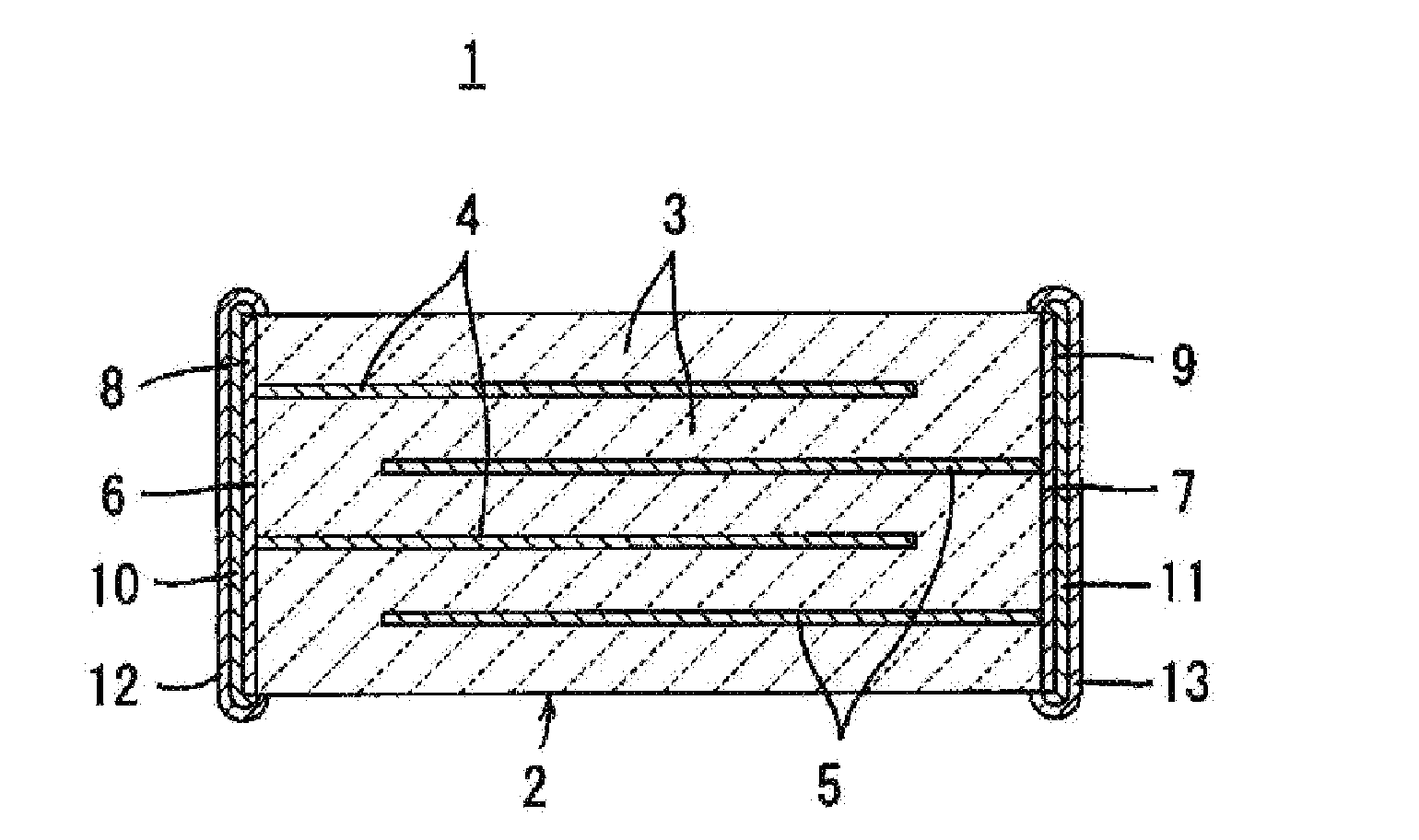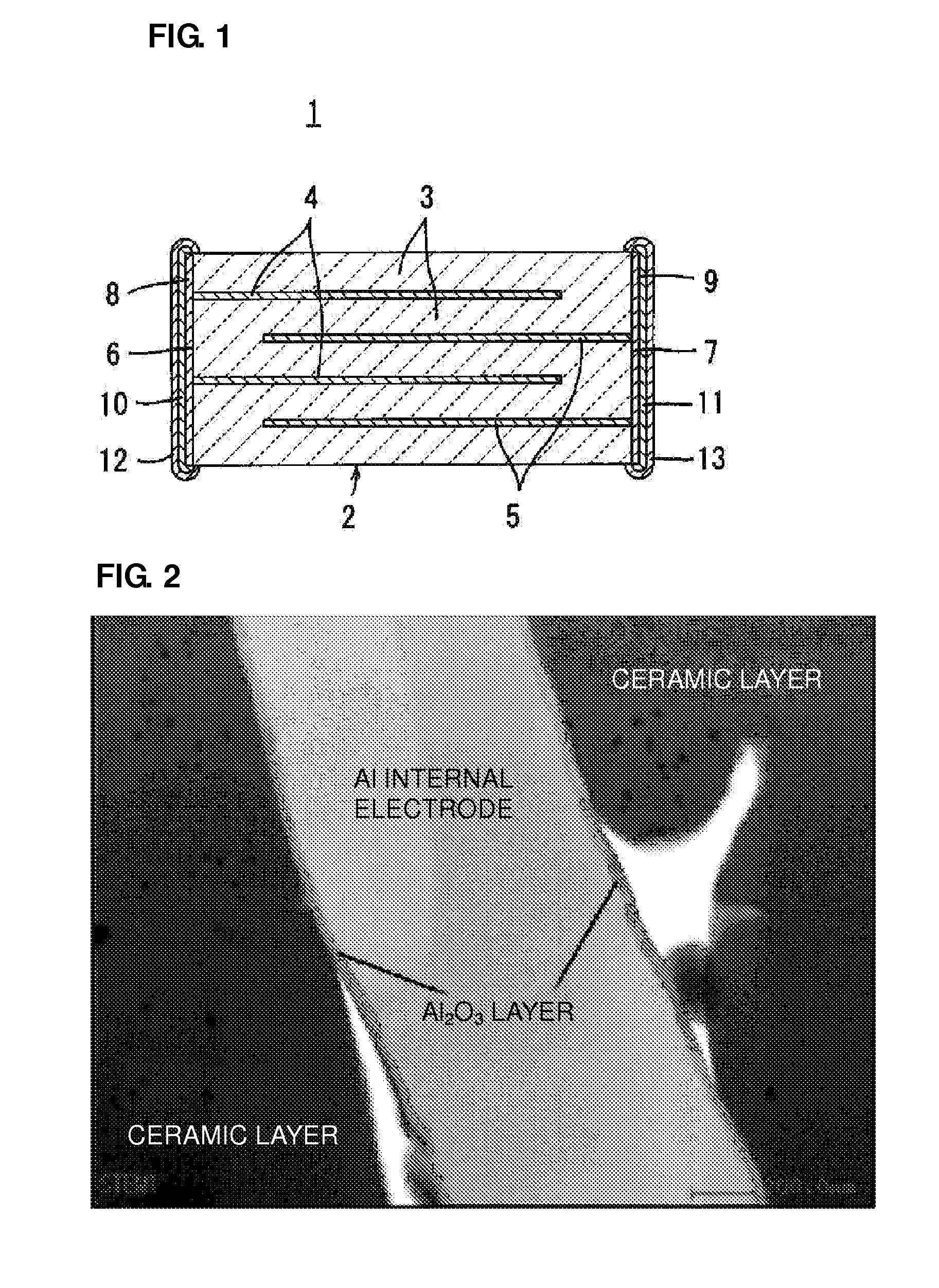Laminated ceramic electronic component and method for producing laminated ceramic electronic component
a technology of laminated ceramics and electronic components, applied in the direction of fixed capacitor details, stacked capacitors, fixed capacitors, etc., can solve the problems of significant limitation in the design freedom of ceramic materials, delamination and cracks, etc., and achieve superior mechanical properties and electrical properties, superior in terms of smoothness and conductivity, and high degree of dimensional accuracy
- Summary
- Abstract
- Description
- Claims
- Application Information
AI Technical Summary
Benefits of technology
Problems solved by technology
Method used
Image
Examples
example 1
[0035]The present example is intended to examine the dependence on the presence or absence and thickness of an Al2O3 layer in laminated ceramic electronic components which have six different types of ceramic compositions and Al internal electrodes.
[0036]First, a BaTiO3 powder was prepared as a main constituent of a ceramic, and Bi2O3, CuO, B2O3, BaO, and SiO2 powders were prepared as accessory constituents. These powders were mixed so as to satisfy the six types of content rates shown in Table 1, thereby providing six types of ceramic raw materials.
TABLE 1BaTiO3Bi2O3CuOB2O3BaOSiO2Composition(mol %)(mol %)(mol %)(mol %)(mol %)(mol %)1-190910001-290730001-390800201-490802001-55025000251-6503500015
[0037]An ethanol-based organic solvent and a polyvinyl butyral based binder were added to each of these ceramic raw materials, followed by wet mixing in a ball mill, to obtain ceramic slurries. The ceramic slurries were subjected to sheet forming to obtain ceramic green sheets.
[0038]Next, an ...
example 2
[0047]The present example is intended to examine the influence in the case of changing internal electrodes from Ni to Al in a certain dielectric ceramic material.
[0048]First, a ceramic raw material represented by the composition formula 100(Ba0.95Ca0.05)1.01TiO3+0.2Dy2O3+0.1 MnO+0.6MgO+2.0SiO2+0.5Li2O was prepared.
[0049]This ceramic raw material was used to obtain ceramic green sheets in the same way as in Example 1. In parallel, an Al paste including an Al metal powder and an organic vehicle and a Ni paste including a Ni metal powder and an organic vehicle were prepared.
[0050]Next, the Al paste was applied by screen printing onto the ceramic green sheets to form Al paste layers. The ceramic green sheets with the Al paste applied were stacked so that the sides to which the Al paste layers were drawn were alternated, followed by pressure bonding, thereby providing a raw laminate. In the same way, a raw laminate was obtained in the case of using the Ni paste.
[0051]The raw laminates we...
example 3
[0057]The present example is intended to evaluate laminates including Al internal electrodes with a variety of compositions as ceramic compositions for firing at low temperatures.
[0058]First, respective starting raw materials were mixed so as to satisfy the compositions shown in Table 4, thereby providing ceramic raw materials of six types of compositions, raw materials 3-1 to 3-6.
TABLE 4RawMate-Bi2O3SiO2CaZrO3B2O3PbOAl2O3TeO2rial(mol %)(mol %)(mol %)(mol %)(mol %)(mol %)(mol %)3-165353-275253-330703-410903-52983-61.5971.5
[0059]The ceramic raw materials were used to obtain ceramic green sheets in the same way as in Example 1. In parallel, an Al paste including an Al metal powder and an organic vehicle, a Ni paste including a Ni metal powder and an organic vehicle, and a Cu paste including a Cu metal powder and an organic vehicle were prepared.
[0060]Next, the Al paste was applied by screen printing onto the ceramic green sheets from the raw material 3-1 to 3-4 to form Al paste layers...
PUM
| Property | Measurement | Unit |
|---|---|---|
| Temperature | aaaaa | aaaaa |
| Temperature | aaaaa | aaaaa |
| Pressure | aaaaa | aaaaa |
Abstract
Description
Claims
Application Information
 Login to View More
Login to View More - R&D
- Intellectual Property
- Life Sciences
- Materials
- Tech Scout
- Unparalleled Data Quality
- Higher Quality Content
- 60% Fewer Hallucinations
Browse by: Latest US Patents, China's latest patents, Technical Efficacy Thesaurus, Application Domain, Technology Topic, Popular Technical Reports.
© 2025 PatSnap. All rights reserved.Legal|Privacy policy|Modern Slavery Act Transparency Statement|Sitemap|About US| Contact US: help@patsnap.com


